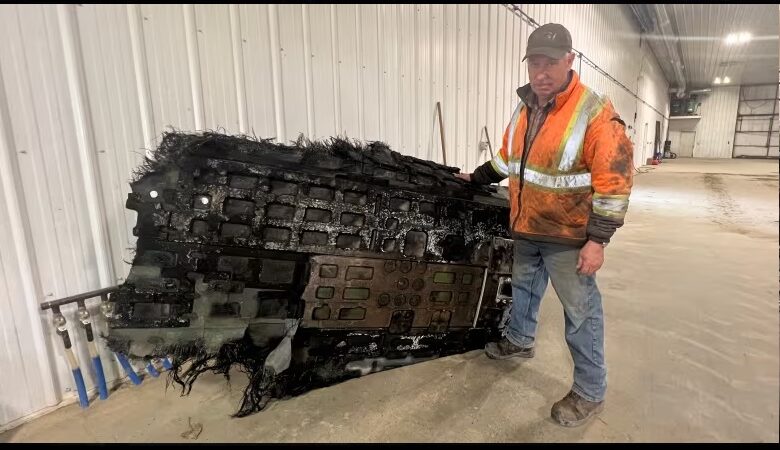Canadian Farmer Discovers Remains Of A Satellite in Farm Fields

News Mania desk/Agnibeena Ghosh/20th May 2024
Farmer Barry Sawchuk and his son stumbled upon an unexpected find while inspecting their canola field near Ituna, a small town in Saskatchewan, Canada: a charred piece of heavy metal. The discovery, believed to be space debris, has sparked intrigue and drawn attention from astronomy experts.
The metal object, measuring approximately 6.5 feet broad and weighing 88 pounds, exhibited characteristics indicative of space debris, including burnt composite fibers and webbing. Despite initial uncertainty, Samantha Lawler, an astronomy professor at Regina University, examined the debris and suggested that it likely originated from the SpaceX Dragon spacecraft, which re-entered the Earth’s atmosphere earlier this year after a mission to the International Space Station (ISS).
The SpaceX Dragon capsule, carrying four astronauts from the private Ax-3 mission, undocked from the ISS on February 7 and returned to Earth on February 9. While the reusable crew capsule safely splashed down off the coast of Daytona, Florida, the disposable trunk module, responsible for cargo storage, re-entered the atmosphere independently. It is this trunk module that likely landed on Barry’s farm.
Barry Sawchuk intends to sell the discovered space debris and donate the proceeds to aid in the construction of a hockey arena in Saskatchewan. However, under international space law, countries are required to return space debris to the nation of origin. In this case, the debris should technically be returned to the United States, where SpaceX is headquartered. Alternatively, SpaceX may opt to relinquish ownership of the space junk.
This incident is reminiscent of a similar occurrence in July 2022 when a SpaceX Dragon trunk module landed on a farmland in Australia. Such events underscore the increasing risk posed by space debris, as human-made objects frequently re-enter the Earth’s atmosphere. While many of these objects disintegrate during reentry, larger fragments may survive and make landfall.
The proliferation of space missions, particularly by companies like SpaceX, suggests that the prevalence of space debris is likely to escalate. According to estimates by the European Space Agency (ESA), over 36,500 debris objects currently orbit the Earth. With the rapid expansion of the space industry, the threat of collisions with space debris looms larger than ever.
SpaceX has yet to officially confirm that the discovered debris belongs to the Dragon spacecraft. However, this incident serves as a reminder of the challenges posed by space debris and the importance of monitoring and mitigating its impact on Earth’s surface. As space exploration continues to advance, efforts to address the issue of space debris will become increasingly crucial to ensuring the safety and sustainability of space activities.






